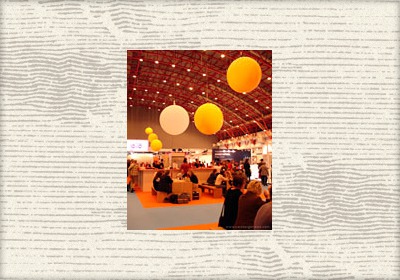Show Review: '100% Design' Product and Furniture Design exhibition
Tue, 16 Nov 2004Now into its tenth year, '100% Design' is a showcase for emerging talent from Britain in the fields of product and furniture design. Held in Earl's Court, London, it also attracts European and Asian companies keen on marking their presence. Whilst the show has come to attract larger corporations too, these companies still often give individual credit to their designers, naming them with each piece displayed. While whimsical bathroom fittings seem to be on the rise, there is still much inspiration at hand for those with more critical tastes. Recently, 100% Design has come to include the supporting exhibitions 100% Detail and 100% Material, which are pretty self-explanatory in name. Though it lacks the kudos of Milan's furniture fair, 100% Design still provokes thought. It has particular relevance to car interior designers, as we see new ways of using lighting and material to create new environments for passengers that are closer to domestic interior design and fashion design.
This year, the evolution of textiles beyond mere fabrics continued. In terms of spacial dimension, the past few years have seen each design discipline move into the next category: photography into graphics, graphics into product, and product into car design for example. Though photography and fashion enjoy the reciprocity of their relationship, textiles has for a long time remained exclusive to fashion as well. This year's 100% Design show reveals the continued assertion of textile design, as it moves to inspire graphic and product design more profoundly.
The Ribbon Project, founded in Japan, is an example of fabric being used beyond the parameters of clothing, as tightly coiled strips of ribbon are used to form bowls and tables, for example, appearing as if created on a lathe with surprising weight and solidity.
Helen Murray displayed her innovative designs, using layers of polyester wadding to create floral relief for furniture and friezes. Her work demonstrates how textile design is moving beyond texture to three dimensions, with her sharply cut cloth creating a unique graphical image. Polyester also appeared in its solid form in the shape of Sour Designs bathroom tiles, which resist cracks and can be pigmented.
Just as Murray's work finds textile design's third dimension, the work of Wedgwood takes illustration into graphics. Details of the delicate images that are usually drawn on their plates are greatly enlarged, causing it to be the identity of the plate, rather than just the decoration. Nada Debs of East & East also reviews decoration. Debs' furniture borrows the architectural minimalism from Japan, and uses patterns made of tin and mother-of-pearl from her native Lebanon. Though the concept is antagonistic, the outcome is refined, with the Japanese influence toning down the Persian flamboyance that can be off-putting in the relatively sober Western market. Beyond the architecture, patterns are repeated, causing the necessary order in the graphics of her pieces.
Company 'Pinch' were voted the best newcomers of the show. Their most notable piece being a side-board featuring layered ripples in an execution not entirely dissimilar to the inside of the Renault Talisman. Elsewhere, honeysuckles in the vein of William Morris seemed to provide inspiration for a range of lampshades. Having cut out the shape of the image, it was then rotated about the y-axis to create the necessary floral image. Though the silhouette is extracted from print, it too adopts a third dimension, creating a successful product, both original in its concept, and witty in its execution.
100% Material is a new extension to this popular exhibition, though due to the small size of the samples available, it takes a while to get understand each piece. Examples of oxygenated aluminium resembled metallic foam, light in weight with great rigidity. Various companies adopted the honeycomb in enforcing their materials, while of more interest is where different materials have been brought together in one piece. Strategically, this is unusual. It's like a Mercedes using a Honda engine. The results, however, were most attractive. Rapier Crystal Ply is particularly so, fusing plywood and Perspex together for a semi-transparent hybrid. Alucobond is a sandwich of polyethylene between aluminium sheet. This can be scored for precise bending, and is suitable for basic shapes with flat surfaces, though the scoring itself presents an interesting image.
Coming from the same stable as Yo! Sushi and Yo! Japan, Yotel was launched at this year's show. The concept draws inspiration from Tokyo's capsule hotels in terms of packaging, though it mercifully provides more space and privacy.
Simon Woodroffe's brainchild brings Good Taste to the masses, and is beautifully realised. Though Priestman Goode's proposal for the interior seems to borrow from Apple's Jonathan Ive in terms of overall language, most people who pay the necessary ?70 per night won't be too critical. In terms of affordable hotel accommodation in Britain, it is a massive leap forwards, though in the pursuit of general style development, it does not move beyond Apple. That said, its bathroom fittings are terrific.
By



